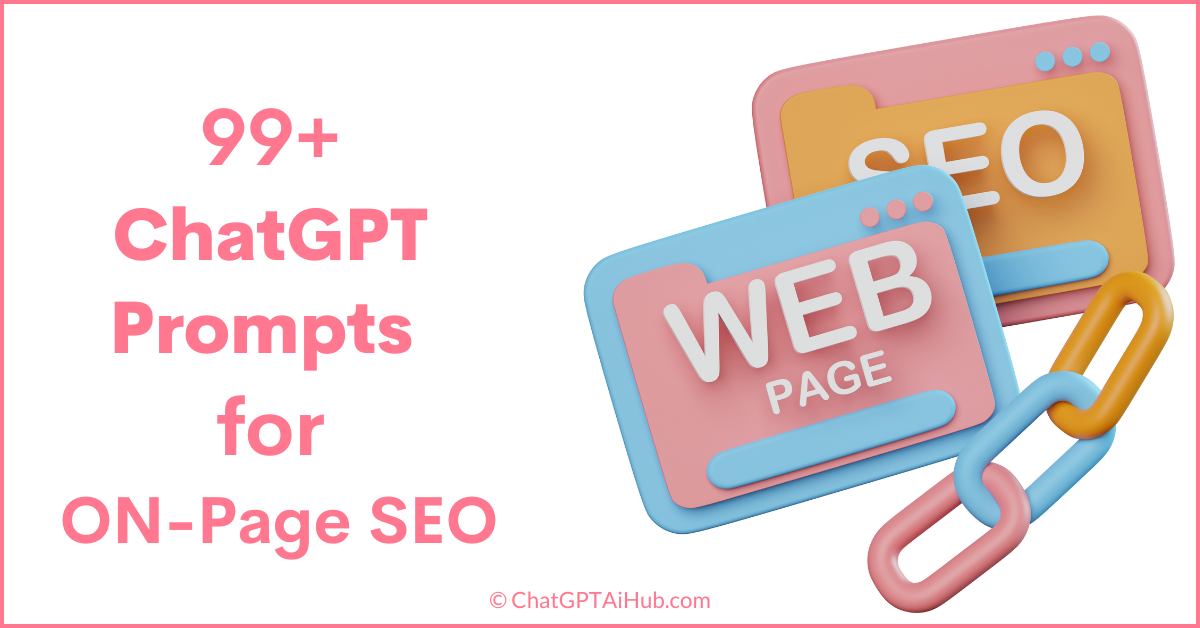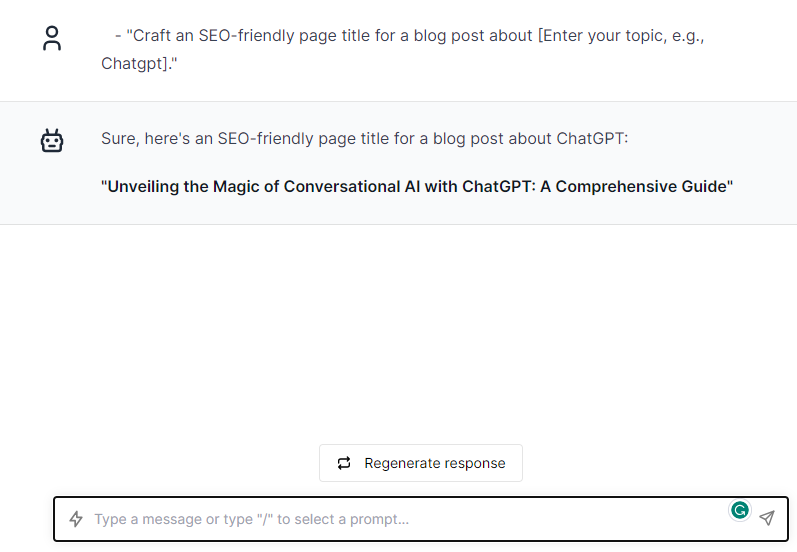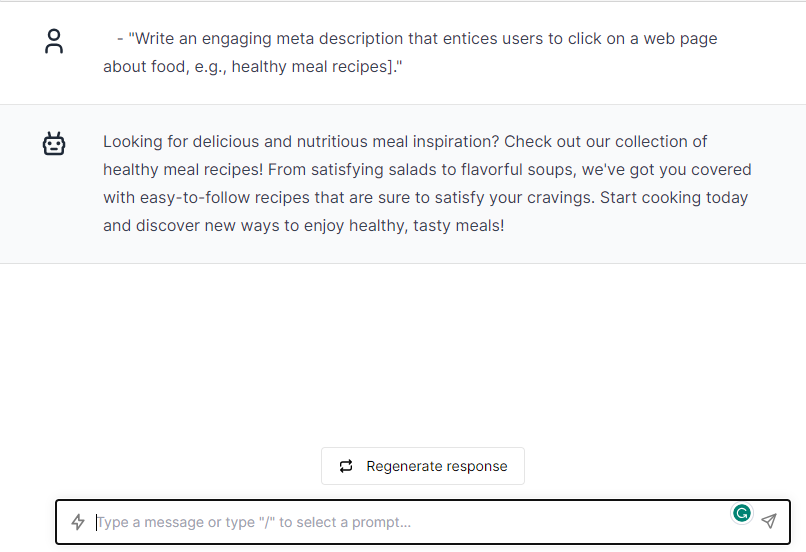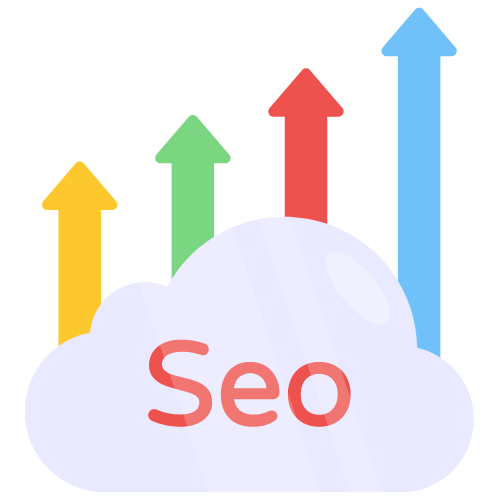99+ Powerful ChatGPT Prompts for On-Page SEO: Boost Your Website’s Visibility

Looking for a way to optimize your website’s On-Page SEO? Look no further than ChatGPT Prompts for On-Page SEO. As an AI language model, ChatGPT has the ability to generate text based on user-provided prompts. By inputting specific phrases or keywords relating to your website’s content, ChatGPT can generate valuable keywords and phrases to improve your site’s On-Page SEO. In this blog post, we’ll discuss the best ChatGPT prompts for optimizing your site’s On-Page SEO, ensuring that your website ranks higher and attracts more traffic. So, let’s get started with “ChatGPT Prompts for On-Page SEO.
Challenge with On-Page SEO
The problem with On-Page SEO is that it can be immensely time-consuming and challenging, with so many factors determining a page’s ranking. Without proper optimization, your site can potentially be buried among thousands of search engine results. Fortunately, ChatGPT prompts can help establish the necessary keywords and phrases to help improve your On-Page SEO in a much smoother and more efficient manner. With ChatGPT prompts, you can take your website’s ranking to the next level.
Through this article, learn the best ChatGPT prompts for On-Page SEO, as well as how to utilize them effectively to improve their website’s search ranking. By utilizing these prompts correctly, readers will benefit from increased website traffic and visibility, leading to higher conversion rates and a more successful online presence.
Visit Here: 1200+ ChatGPT Prompts For Copywriting
Why ChatGPT Prompts for On-Page SEO is a Must-Have for Your Website’s Success
Optimizing On-Page SEO is vital for any website wanting to rank highly on search engines and drive organic traffic. Without proper optimization, your website is unlikely to receive relevant traffic and will likely go unnoticed. This is where ChatGPT prompts come into play. By utilizing ChatGPT prompts, you can identify the most relevant keywords and phrases for your content, to ensure that your website is optimized and your content is directed towards the right audience.
Incorporating ChatGPT prompts into your On-Page SEO strategy can lead to increased website visibility, higher conversion rates, and a more successful online presence. By accurately identifying the most efficient and relevant keywords, your website can attract potential customers, direct relevant traffic to your content, and keep visitors engaged and coming back for more. As the competition for online visibility continues to grow, incorporating ChatGPT prompts into your On-Page SEO strategy can give you a distinct advantage over your competitors and bring your website the traffic, engagement, and success it deserves.
Visit Here: 1300+ ChatGPT Prompts For SEO
A Single Master Prompt For On-Page SEO
Act as an On Page Seo Expert I’m here to create an ON page SEO On [topic]. To get started, please provide the main focus or [Sub topic] for the On-page SEO topic. Once you share the relevant topic and focus, I will ask you a series of questions step by step to gather all the necessary information for the academic topic (At the start Ask me what type of On-Page SEO part I want like meta description, etc). These questions will be relevant to the On-Page SEO topic What do you want to write about like solutions questions etc, which special insight of the On-Page topic you can give me to write, and how many crucial parts do you want to include in the Strategy? etc. You, as the user, will answer each question one by one, and I will extract as much information as I can to ensure the content meets your needs. There will be at least 5 questions and up to 10 questions in total, all aimed at understanding your requirements and creating tailored academic topic parts. The next question will be asked only after you provide your response to the previous one like a survey only one question at a time. after these questions, I will write an On-Page SEO topic with a proper outline, introduction, and proper body and have proper paragraphs if any, about what you can expect from me with all the headings,
99+ ChatGPT Prompts for On-Page SEO: The Ultimate List
1. Optimize your Page Title:
– “Craft an SEO-friendly page title for a blog post about [Enter your topic, e.g., digital marketing strategies].”

– “Create a compelling page title that includes relevant keywords for a product page on [Enter your product or service].”
2. Write Meta Descriptions:
– “Write an engaging meta description that entices users to click on a web page about [Enter your topic, e.g., healthy meal recipes].”

– “Craft a concise meta description that accurately summarizes the content of a landing page related to [Enter your industry, e.g., fitness equipment].”
3. Incorporate Relevant Keywords:
– “Identify and integrate long-tail keywords into the content of a blog post about [Enter your topic, e.g., effective time management techniques].”

– “Research and include primary and secondary keywords in the product description for [Enter your product or service].”
4. Optimize Header Tags:
– “Optimize the H1 tag for a webpage focused on [Enter your topic, e.g., home organization tips].”
– “Utilize H2 tags to structure the content of a landing page dedicated to [Enter your industry, e.g., sustainable fashion].”
5. Create Descriptive Alt Text for Images:
– “Write descriptive alt text for an image of [Enter your image subject, e.g., a dog playing in a park] on a blog post about [Enter your topic].”
– “Generate alt text that accurately describes an image showcasing [Enter your product or service].”
6. Implement Internal Linking:
– “Identify key anchor text and internal links to include in a blog post about [Enter your topic, e.g., travel tips].”
– “Create relevant anchor text and internal links to connect product pages within your [Enter your website or online store].”
7. Optimize URL Structure:
– “Suggest a user-friendly and SEO-friendly URL structure for a blog post titled [Enter your blog post title].”
– “Restructure the URL of a product category page to make it concise and keyword-rich for [Enter your industry].”
8. Write Engaging and Informative Content:
– “Generate informative and valuable content for a service page on [Enter your business, e.g., digital marketing agency].”
– “Craft compelling and engaging content for a blog post addressing [Enter your topic, e.g., effective social media strategies].”
9. Include Schema Markup:
– “Identify suitable schema markup for a recipe page featuring [Enter your recipe, e.g., homemade pasta].”
– “Implement schema markup for a product page showcasing [Enter your product, e.g., smartwatches].”
10. Optimize Page Loading Speed:
– “Provide optimization suggestions to improve the loading speed of a landing page focused on [Enter your industry, e.g., real estate].”
– “Optimize images, minify CSS and JavaScript files, and implement caching techniques to enhance the page loading speed of [Enter your website or web page].”
11. Optimize Meta Keywords:
– “Identify relevant meta keywords to include in a web page about [Enter your topic, e.g., healthy living].”
– “Craft a set of meta keywords that accurately represent the content of a landing page related to [Enter your industry, e.g., fitness accessories].”
12. Create SEO-friendly Permalinks:
– “Suggest an SEO-friendly permalink structure for a blog post titled [Enter your blog post title].”
– “Restructure the permalink of a product page to include relevant keywords for [Enter your industry].”
13.
Optimize Image File Names:
– “Rename image files to include descriptive keywords for an article about [Enter your topic, e.g., home renovation tips].”
– “Optimize image file names for product images showcasing [Enter your product or service].”
14. Optimize Outbound Links:
– “Ensure that outbound links from a blog post about [Enter your topic, e.g., travel destinations] are relevant and provide value to readers.”
– “Optimize anchor text for outbound links on a resource page related to [Enter your industry, e.g., software development].”
15. Optimize for Mobile Devices:
– “Provide recommendations to improve the mobile responsiveness and usability of a landing page focused on [Enter your industry, e.g., e-commerce].”
– “Optimize font sizes, button placements, and content layout for a mobile version of a website dedicated to [Enter your topic or industry].”
16. Optimize for Voice Search:
– “Identify long-tail keywords and conversational phrases that users are likely to use for voice searches related to [Enter your topic or industry].”
– “Craft content that answers specific questions users may ask through voice search about [Enter your topic, e.g., gardening tips].”
17. Optimize for Featured Snippets:
– “Identify commonly asked questions in your industry and create content that provides concise and informative answers to be featured in snippets.”
– “Structure content using numbered lists or bullet points to increase the chances of appearing as a featured snippet for [Enter your topic, e.g., health benefits of yoga].”
18. Optimize for Local SEO:
– “Optimize the Google My Business listing for [Enter your business or location] by providing accurate and up-to-date information.”
– “Research and include relevant local keywords in the content of a web page targeting [Enter your local area or region, e.g., Los Angeles].”
19. Optimize for User Experience:
– “Evaluate the readability and structure of a blog post about [Enter your topic, e.g., home organization] to ensure a smooth user experience.”
– “Improve the navigation and accessibility of a website focused on [Enter your industry or niche] to enhance user experience.”
20. Monitor and Optimize for SEO Performance:
– “Use Google Analytics to analyze the organic search traffic and user behavior for a specific web page or blog post.”
– “Track keyword rankings and identify opportunities for improvement in the search engine results pages (SERPs) for [Enter your target keywords].”
1. Optimize Keyword Placement Within Content:
– “Identify strategic positions within a blog post about [Enter your topic, e.g., digital marketing trends] to include primary keywords.”
– “Optimize keyword placement in the introduction and conclusion paragraphs of a landing page focused on [Enter your industry, e.g., fashion accessories].”
2. Optimize Header Tag Hierarchy:
– “Ensure a logical hierarchy of header tags (H1 to H6) in a web page about [Enter your topic, e.g., healthy cooking recipes].”
– “Review and adjust the header tag structure of a product category page for [Enter your industry, e.g., electronics].”
3. Optimize content length:
– “Analyze the optimal content length for a blog post addressing [Enter your topic, e.g., weight loss tips] based on industry standards and user intent.”
– “Provide recommendations to increase or decrease the content length of a service page on [Enter your business, e.g., digital marketing agency].”
4. Improve readability:
– “Suggest ways to enhance the readability of a web page focused on [Enter your topic, e.g., home decor ideas] by using shorter sentences and clear headings.”
– “Evaluate the use of subheadings, bullet points, and paragraphs in a landing page related to [Enter your industry, e.g., fitness supplements] to improve readability.”
5. Optimize internal anchor text:
– “Identify and optimize anchor text for internal links within a blog post about [Enter your topic, e.g., travel tips for solo adventurers].”
– “Review and update anchor text for internal links on a product page showcasing [Enter your product or service].”
6. Optimize for semantic SEO:
– “Identify related keywords and concepts to include in the content of a blog post about [Enter your topic, e.g., social media marketing strategy].”
– “Craft content that addresses user intent and provides comprehensive information on a landing page related to [Enter your industry, e.g., health supplements].”
7. Optimize image file sizes:
– “Provide recommendations to reduce the file size of images on a blog post about [Enter your topic, e.g., photography techniques] without compromising quality.”
– “Optimize image compression and formats for product images showcasing [Enter your product or service] to improve page loading speed.”
8. Optimize for local intent:
– “Identify location-specific keywords to include in the content of a landing page targeting [Enter your local area or region, e.g., New York City].”
– “Craft content that emphasizes the relevance of your business to the local community on a web page focused on [Enter your industry or niche].”
9. Optimize for rich snippets:
– “Identify structured data markup opportunities for a web page about [Enter your topic, e.g., healthy recipes] to enhance the chances of appearing as a rich snippet.”
– “Implement schema markup to optimize a product page showcasing [Enter your product or service] for rich snippets.”
10. Optimize for social sharing:
– “Include social media sharing buttons and optimized meta tags for social platforms on a blog post addressing [Enter your topic, e.g., mindfulness techniques].”
– “Craft compelling social media snippets for a landing page related to [Enter your industry, e.g., fashion accessories] to encourage social sharing.”
11. Optimize URL slugs:
– “Suggest an SEO-friendly URL slug for a blog post titled [Enter your blog post title] that includes relevant keywords.”
– “Optimize the URL slug of a product page to make it concise and descriptive for [
Enter your industry, e.g., automotive accessories].”
12. Optimize for mobile-first indexing:
– “Evaluate the mobile responsiveness and usability of a web page focused on [Enter your topic or industry] to ensure compatibility with mobile-first indexing.”
– “Optimize font sizes, button placements, and content visibility for a mobile version of a website dedicated to [Enter your industry or niche].”
Remember, adapt these prompts to suit your specific website, content, and target audience. Customizing them will help you optimize your on-page SEO efforts effectively.
Certainly! Here are 60 additional prompts for on-page SEO:
1. Optimize keyword placement within content:
– “Identify strategic positions within a blog post about [Enter your topic, e.g., digital marketing trends] to include primary keywords.”
– “Optimize keyword placement in the introduction and conclusion paragraphs of a landing page focused on [Enter your industry, e.g., fashion accessories].”
2. Optimize header tag hierarchy:
– “Ensure a logical hierarchy of header tags (H1 to H6) in a web page about [Enter your topic, e.g., healthy cooking recipes].”
– “Review and adjust the header tag structure of a product category page for [Enter your industry, e.g., electronics].”
3. Optimize content length:
– “Analyze the optimal content length for a blog post addressing [Enter your topic, e.g., weight loss tips] based on industry standards and user intent.”
– “Provide recommendations to increase or decrease the content length of a service page on [Enter your business, e.g., digital marketing agency].”
4. Improve readability:
– “Suggest ways to enhance the readability of a web page focused on [Enter your topic, e.g., home decor ideas] by using shorter sentences and clear headings.”
– “Evaluate the use of subheadings, bullet points, and paragraphs in a landing page related to [Enter your industry, e.g., fitness supplements] to improve readability.”
5. Optimize internal anchor text:
– “Identify and optimize anchor text for internal links within a blog post about [Enter your topic, e.g., travel tips for solo adventurers].”
– “Review and update anchor text for internal links on a product page showcasing [Enter your product or service].”
6. Optimize for semantic SEO:
– “Identify related keywords and concepts to include in the content of a blog post about [Enter your topic, e.g., social media marketing strategy].”
– “Craft content that addresses user intent and provides comprehensive information on a landing page related to [Enter your industry, e.g., health supplements].”
7. Optimize image file sizes:
– “Provide recommendations to reduce the file size of images on a blog post about [Enter your topic, e.g., photography techniques] without compromising quality.”
– “Optimize image compression and formats for product images showcasing [Enter your product or service] to improve page loading speed.”
8. Optimize for local intent:
– “Identify location-specific keywords to include in the content of a landing page targeting [Enter your local area or region, e.g., New York City].”
– “Craft content that emphasizes the relevance of your business to the local community on a web page focused on [Enter your industry or niche].”
9. Optimize for rich snippets:
– “Identify structured data markup opportunities for a web page about [Enter your topic, e.g., healthy recipes] to enhance the chances of appearing as a rich snippet.”
– “Implement schema markup to optimize a product page showcasing [Enter your product or service] for rich snippets.”
10. Optimize for social sharing:
– “Include social media sharing buttons and optimized meta tags for social platforms on a blog post addressing [Enter your topic, e.g., mindfulness techniques].”
– “Craft compelling social media snippets for a landing page related to [Enter your industry, e.g., fashion accessories] to encourage social sharing.”
11. Optimize URL slugs:
– “Suggest an SEO-friendly URL slug for a blog post titled [Enter your blog post title] that includes relevant keywords.”
– “Optimize the URL slug of a product page to make it concise and descriptive for [
Enter your industry, e.g., automotive accessories].”
12. Optimize for mobile-first indexing:
– “Evaluate the mobile responsiveness and usability of a web page focused on [Enter your topic or industry] to ensure compatibility with mobile-first indexing.”
– “Optimize font sizes, button placements, and content visibility for a mobile version of a website dedicated to [Enter your industry or niche].”
Remember, adapt these prompts to suit your specific website, content, and target audience. Customizing them will help you optimize your on-page SEO efforts effectively.
Visit Here: 1351+ ChatGPT Prompts for Blog Posts Writing
Get 99+ ChatGPT Prompts for On-Page SEO- Complete List
Free Prompts forever

Final Thoughts:
In conclusion, incorporating ChatGPT prompts into your On-Page SEO strategy can significantly boost your website’s search engine ranking and visibility, leading to increased traffic and higher conversion rates. With the comprehensive list of 99+ ChatGPT prompts for On-Page SEO that we covered in this article, you’re equipped with all the necessary tools to optimize your website efficiently and effectively. Additionally, we emphasized the importance of conducting effective keyword research, creating compelling title tags and meta descriptions, and prioritizing user experience to create a successful website.
By implementing these strategies, your website will stand out from the competition, drive organic traffic, and achieve the success it deserves. So, it’s time to leverage ChatGPT prompts and take your On-Page SEO to the next level!

